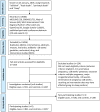Associations between symptoms of sleep-disordered breathing and maternal sleep patterns with late stillbirth: Findings from an individual participant data meta-analysis
- PMID: 32214393
- PMCID: PMC7098581
- DOI: 10.1371/journal.pone.0230861
Associations between symptoms of sleep-disordered breathing and maternal sleep patterns with late stillbirth: Findings from an individual participant data meta-analysis
Abstract
Background and objectives: Sleep-disordered breathing (SDB) affects up to one third of women during late pregnancy and is associated with adverse pregnancy outcomes, including hypertension, diabetes, impaired fetal growth, and preterm birth. However, it is unclear if SDB is associated with late stillbirth (≥28 weeks' gestation). The aim of this study was to investigate the relationship between self-reported symptoms of SDB and late stillbirth.
Methods: Data were obtained from five case-control studies (cases 851, controls 2257) from New Zealand (2 studies), Australia, the United Kingdom, and an international study. This was a secondary analysis of an individual participant data meta-analysis that investigated maternal going-to-sleep position and late stillbirth, with a one-stage approach stratified by study and site. Inclusion criteria: singleton, non-anomalous pregnancy, ≥28 weeks' gestation. Sleep data ('any' snoring, habitual snoring ≥3 nights per week, the Berlin Questionnaire [BQ], sleep quality, sleep duration, restless sleep, daytime sleepiness, and daytime naps) were collected by self-report for the month before stillbirth. Multivariable analysis adjusted for known major risk factors for stillbirth, including maternal age, body mass index (BMI kg/m2), ethnicity, parity, education, marital status, pre-existing hypertension and diabetes, smoking, recreational drug use, baby birthweight centile, fetal movement, supine going-to-sleep position, getting up to use the toilet, measures of SDB and maternal sleep patterns significant in univariable analysis (habitual snoring, the BQ, sleep duration, restless sleep, and daytime naps). Registration number: PROSPERO, CRD42017047703.
Results: In the last month, a positive BQ (adjusted odds ratio [aOR] 1.44, 95% confidence interval [CI] 1.02-2.04), sleep duration >9 hours (aOR 1.82, 95% CI 1.14-2.90), daily daytime naps (aOR 1.52, 95% CI 1.02-2.28) and restless sleep greater than average (aOR 0.62, 95% CI 0.44-0.88) were independently related to the odds of late stillbirth. 'Any' snoring, habitual snoring, sleep quality, daytime sleepiness, and a positive BQ excluding the BMI criterion, were not associated.
Conclusion: A positive BQ, long sleep duration >9 hours, and daily daytime naps last month were associated with increased odds of late stillbirth, while sleep that is more restless than average was associated with reduced odds. Pregnant women may be reassured that the commonly reported restless sleep of late pregnancy may be physiological and associated with a reduced risk of late stillbirth.
Conflict of interest statement
Associate Professor O’Brien reports grants from ResMed outside the submitted work. This does not alter our adherence to PLOS ONE policies on sharing data and materials.
Figures


References
-
- Reinebrant HE, Leisher SH, Coory M, Henry S, Wojcieszek AM, Gardener G, et al. Making stillbirths visible: a systematic review of globally reported causes of stillbirth. BJOG: An International Journal of Obstetrics & Gynaecology. 2017. - PubMed
Publication types
MeSH terms
LinkOut - more resources
Full Text Sources
Medical

